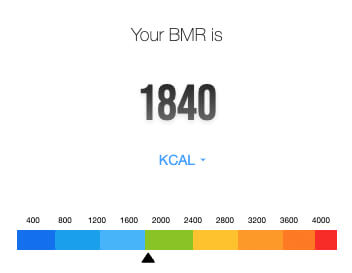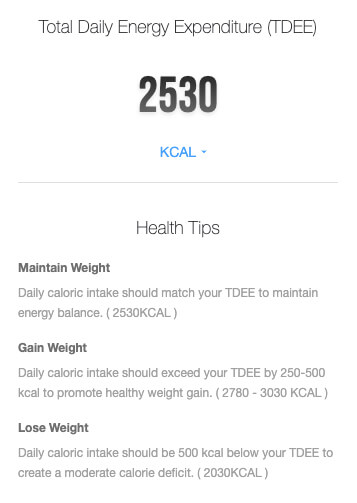BMR Calculator - Basal Metabolic Rate Calculation
 Give Feedback
Give FeedbackWhat is BMR?
Basal Metabolic Rate (BMR) refers to the minimum amount of energy the body needs to maintain basic physiological functions, such as breathing, heartbeat, temperature regulation, and cell repair, while at rest. It represents the calories your body burns to sustain life without any additional activity. BMR is typically expressed as the number of calories burned per day and can be influenced by factors like age, gender, weight, height, and body composition. For example, as people age, muscle mass tends to decrease, slowing down the metabolic rate, which in turn lowers BMR. Additionally, men generally have a higher BMR than women due to their higher muscle mass, as muscle burns more calories than fat.
Understanding BMR is crucial for effective health management. Knowing your BMR can help you create a scientifically sound diet and exercise plan to achieve weight management goals. For instance, individuals aiming to lose weight can use BMR to ensure their daily caloric intake is less than their energy expenditure, while those looking to gain muscle can use BMR to ensure they are consuming enough calories to support muscle growth. To get a more precise estimate of your total energy needs, it's important to consider your Total Daily Energy Expenditure (TDEE), which includes all daily activities in addition to BMR.
How to Calculate BMR?
Common BMR Formulas
There are three widely used formulas for calculating BMR: Mifflin-St Jeor, Revised Harris-Benedict, and Katch-McArdle. Each has its own specific use case and target audience. Below is a detailed introduction:
1. Mifflin-St Jeor Formula
The Mifflin-St Jeor Formula is considered one of the most accurate modern BMR formulas and is widely used in health management and weight control. This formula estimates BMR based on four key factors: gender, age, weight, and height:
For Men:
$$ BMR = 10 \times \text{weight(kg)} + 6.25 \times \text{height(cm)} - 5 \times \text{age(years)} + 5 $$For Women:
$$ BMR = 10 \times \text{weight(kg)} + 6.25 \times \text{height(cm)} - 5 \times \text{age(years)} - 161 $$The advantage of this formula is that it has been updated for modern lifestyles and reflects the metabolic needs of most people today.
2. Revised Harris-Benedict Formula
The Harris-Benedict Formula was first introduced in 1919 and later revised in 1984 to accommodate a wider range of body types and activity levels. The formula has been adapted to suit modern populations.
For Men:
$$ BMR = 88.362 + 13.397 \times \text{weight(kg)} + 4.799 \times \text{height(cm)} - 5.677 \times \text{age(years)} $$For Women:
$$ BMR = 447.593 + 9.247 \times \text{weight(kg)} + 3.098 \times \text{height(cm)} - 4.330 \times \text{age(years)} $$While some studies suggest that the Mifflin-St Jeor formula may be more precise, the Harris-Benedict formula remains a popular and effective method, especially in research settings.
3. Katch-McArdle Formula
The Katch-McArdle Formula is ideal for those who know their body fat percentage, as it primarily calculates BMR based on lean body mass. This formula is more commonly used by athletes and fitness enthusiasts:
Katch-McArdle Formula:
$$ BMR = 370 + 21.6 \times \text{lean body mass(kg)} $$Lean body mass refers to total body weight minus fat, so you need to determine your body fat percentage first. This method can provide highly accurate BMR values when body fat data is precise.
How to Use HealthyCalc’s Online BMR Calculator
HealthyCalc offers a simple, user-friendly online tool that helps users quickly calculate both BMR and Total Daily Energy Expenditure (TDEE). Here are the steps and instructions:
1. Select the BMR Calculation Formula
On the calculator interface, select one of the three common BMR formulas:
- Mifflin-St Jeor (recommended for most users)
- Revised Harris-Benedict
- Katch-McArdle (for users who know their body fat percentage)
Most users will find the Mifflin-St Jeor formula to be the best choice by default.

2. Input Personal Information
After selecting the formula, users need to input the following information:
- Gender: Select male or female
- Height: Enter your height (supports both metric and imperial units)
- Weight: Enter your weight (supports both kilograms and pounds)
- Age: Enter your age
- Body Fat Percentage: Only required for the Katch-McArdle formula to calculate lean body mass.
Once all information is entered, the BMR value, representing your minimum daily energy requirement at rest, will be automatically calculated. A color-coded indicator will show whether the BMR is within a healthy range.
3. Select Activity Level
The HealthyCalc BMR calculator not only calculates your BMR but also estimates your Total Daily Energy Expenditure (TDEE) based on your activity level. After entering your basic information, you will need to select your daily activity level. The options include:
- Sedentary: Little to no physical activity, such as desk work, watching TV, or other low-effort tasks.
- Light Activity: Engaging in light physical activities 1-3 times per week, such as walking, light housework, or recreational exercise.
- Moderate Activity: Exercising moderately 3-5 times per week, including activities like jogging, swimming, or weight training.
- High Activity: Performing high-intensity exercise or physical labor nearly every day, such as running, cycling, or heavy lifting.
- Very High Activity: Daily high-intensity workouts or physically demanding jobs, such as professional athletes or construction workers.
- Extreme Activity: Engaging in extremely intense physical training or labor every day, like military training or marathon preparation.
4. View TDEE Results and Health Tips
Once all inputs are complete, the HealthyCalc tool will calculate your TDEE and provide basic health tips based on your energy needs.

Important Tips for Using the BMR Calculator
Ensure Accuracy: Double-check the accuracy of your height, weight, and age, and make sure the correct units are selected.
Choose the Right Formula: Use Mifflin-St Jeor or Harris-Benedict if you don't know your lean body mass. If you're an athlete or fitness enthusiast with a known body fat percentage, use the Katch-McArdle formula.
Select the Correct Activity Level: Be honest about your daily activity level to get an accurate TDEE estimate.
Use BMR and TDEE Estimates Carefully: These calculations are estimates. Combine them with other health indicators for better diet and exercise planning.
Regularly Update Your Data: Recalculate BMR as your weight, age, or body composition changes.
Factors That Influence BMR
BMR is not a fixed value and is affected by several factors. Understanding these factors can help you better interpret and predict changes in BMR.
1. Age
BMR tends to decrease with age due to the natural loss of muscle mass, which is metabolically active tissue. Muscle loss leads to less energy being required for basic functions, and the metabolic rate slows down.
- Impact: BMR decreases by approximately 1-2% every decade after age 30.
2. Gender
Men typically have higher BMRs than women, largely due to higher muscle mass. Even at rest, muscle requires more energy to maintain than fat.
- Impact: Men's BMR is usually 5-10% higher than women's for the same height, weight, and age.
3. Weight and Height
Larger individuals (both in terms of weight and height) have higher BMRs because their bodies require more energy to maintain basic functions.
- Impact: The larger your body, the higher your BMR.
4. Body Composition
Muscle burns more calories than fat. Therefore, individuals with a higher muscle-to-fat ratio have a higher BMR.
- Impact: More muscle equals a higher BMR.
5. Hormones
Hormones, particularly thyroid hormones, play a key role in regulating metabolism. Hyperthyroidism increases BMR, while hypothyroidism decreases it. Other hormones like insulin and adrenaline also affect metabolism.
- Impact: Hormonal imbalances can significantly raise or lower BMR.
6. Genetics
Some people are naturally predisposed to having a faster or slower metabolism due to their genetic makeup.
- Impact: Genetics can make your BMR higher or lower than average.
7. Environmental Temperature
Your body uses more energy to maintain body temperature in cold environments, which temporarily raises BMR. In hot environments, the body may reduce its metabolic rate.
- Impact: Cold environments raise BMR, while hot environments may lower it.
8. Health Conditions
Illness, fever, and surgery can increase the body's energy needs, raising BMR. Chronic illnesses and certain medications may also affect BMR.
- Impact: Health issues can increase or decrease BMR.
9. Diet
High-protein diets can temporarily increase BMR, as digesting and metabolizing protein requires more energy. Long-term dieting or extremely low caloric intake can lower BMR as the body shifts into "energy-saving" mode.
- Impact: High-protein diets raise BMR
; long-term low-calorie diets lower it.
The Limitations and Applications of BMR
Although BMR is a key tool for estimating energy needs, it has some limitations. Understanding these limitations can help you apply BMR more effectively in your health management plan.
1. Limitations of BMR
BMR Reflects Resting Energy Needs Only: BMR represents energy expenditure at complete rest, but daily energy use includes activities, exercise, and other factors. Relying solely on BMR doesn't give a full picture of your energy needs.
Individual Differences Are Not Fully Accounted For: BMR formulas don’t consider factors like genetics, metabolic efficiency, or variations in muscle-to-fat ratio. These differences can cause the same BMR value to have different outcomes for different people.
Not Suitable for Special Populations: BMR formulas are designed for healthy adults. People with conditions like thyroid dysfunction, pregnant women, or those recovering from major illness need more personalized assessments.
Temporary Changes Affect BMR: Short-term factors such as extreme dieting or high-intensity exercise may temporarily alter BMR, making the calculated value less reflective of actual needs.
2. Practical Uses of BMR
Weight Management: BMR is essential for weight management. By combining BMR with TDEE, individuals can tailor strategies for weight loss, maintenance, or muscle gain.
Creating Diet Plans: Knowing your BMR can help structure a balanced diet that meets your metabolic needs. You can adjust macronutrient intake to support metabolism and ensure you’re getting enough energy and nutrition.
Optimizing Workout Plans: Athletes can use BMR and TDEE to adjust workout intensity and diet, ensuring they have enough energy to support their training while speeding recovery.
Monitoring Long-Term Health: As BMR changes with age, weight, and muscle mass, regularly calculating BMR helps in adjusting health plans to maintain fitness and body composition over time.
Frequently Asked Questions (FAQ)
1. How To Calculate TDEE From BMR??
TDEE (Total Daily Energy Expenditure) is calculated by multiplying BMR by an activity factor that reflects your daily exercise and lifestyle. Follow these steps:
Calculate your BMR using the HealthyCalc tool by entering basic information (age, gender, height, weight).
Select your activity level:
- Sedentary (little to no exercise): BMR × 1.2
- Light Activity (light exercise 1-3 days a week): BMR × 1.375
- Moderate Activity (moderate exercise 3-5 days a week): BMR × 1.55
- High Activity (intense exercise 6-7 days a week): BMR × 1.725
- Very High Activity (daily intense exercise): BMR × 1.9
- Extreme Activity (very intense physical labor or training, such as military or marathon training): BMR × 2.0
- Multiply your BMR by the activity factor to get your TDEE. This is the number of calories you need to maintain your current weight.
2. Why Is the BMR Calculator Only for Adults Over 18?
BMR formulas are designed for adults because their metabolism is more stable. Children and teenagers have different energy needs due to growth and hormonal changes, so BMR calculations for adults may not provide accurate results for those under 18.
3. What’s the Difference Between BMI and BMR?
- BMI (Body Mass Index): BMI is a measure of body fat based on height and weight. It’s commonly used to determine if someone is underweight, normal weight, overweight, or obese. The formula for BMI is:
Want to calculate your BMI? You can use the HealthyCalc BMI Calculator to get your result.
- BMR (Basal Metabolic Rate): BMR estimates the minimum energy your body needs to maintain basic functions at rest. It is used to determine daily calorie needs when combined with activity levels for calculating TDEE.
References
Mifflin, M.D., St Jeor, S.T., Hill, L.A., Scott, B.J., Daugherty, S.A., & Koh, Y.O. (1990). A new predictive equation for resting energy expenditure in healthy individuals. American Journal of Clinical Nutrition, 51(2), 241-247. Link
Katch, F.I., & McArdle, W.D. (1973). Prediction of body density from simple anthropometric measurements in college-age men and women. Human Biology, 45(3), 445-454.
World Health Organization. BMI Classification. Link
 Disclaimer
Disclaimer

 EN
EN










 Embed Code
Embed Code